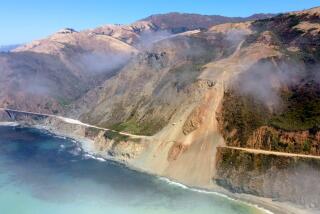Taking Out Bumps Is a Grind
- Share via
It’s not as high-profile as the feverish repair jobs on the shattered Santa Monica and Golden State freeways. Politicians don’t elbow each other for the credit. And many of us may not even notice the difference.
But for months, workers have labored quietly to make post-earthquake freeway driving a less-jarring experience. On weekends, in the late hours when most of us are asleep or in no state to get behind the wheel, swarms of orange-jacketed workers are smoothing out our roadways, erasing a new crop of bumps and humps that were spawned at overpasses by the Northridge earthquake.
Most of them are just a few inches high. But as you zip along at 55 m.p.h. or more, those few inches can throw your car out of alignment, bruise passengers and scrape your tires bald.
Ask Roy Neilson.
“They’re going off all the time,” Neilson says of the alignment on his 10 trucks, which log hundreds of miles on the freeways each week for his plumbing business. “That 405 (Freeway) . . . it’s a mess.”
*
So where did all these new bumps come from, and why do they occur at overpasses?
In the January temblor, the force of the shaking was such that many freeway roadbeds sank. Bridges and overpasses, which are built on separate, stronger foundations of concrete and reinforced steel, stayed put--and are now slightly higher than the rest of the freeway.
The result is a rough ride, mostly along the freeways near the epicenter. The San Diego and Simi Valley freeways were especially hard hit, with smooth patches constantly interrupted by the rises and falls that bookend overpasses.
Ironing out the wrinkles has occupied work crews since April. Although Caltrans spokesman Russell Snyder said exact figures on the number of overpasses affected and the cost of fixing them are not available, estimates put the effort at $3 million to $6 million--only 1% to 2% of the overall $308-million price tag of post-quake highway repairs.
That’s far less than the 16% of the repair bill eaten up by work on the collapsed Santa Monica and Golden State freeways, including the handsome bonuses contractors received for finishing those projects early.
“We’re low-scale compared to that,” said Jim McAllister of Caltrans, who is overseeing the work on one segment of the San Diego Freeway in the southern San Fernando Valley.
The bump project receives none of the glamorous treatment that attended the reopenings of the downed freeways.
“Nobody seems to know what we’re actually doing out here, to be honest,” McAllister said. “But it’s a necessary thing that needs to be done.”
His crews have spent their weekends these last few months tearing up the roadway and pouring fresh concrete in quick-hit overnight projects designed to minimize disruption to motorists.
Under the glare of floodlights, workers dig up the huge slabs of concrete leading to and away from the bridges--”approach slabs” that can stretch as long as 30 feet. Beneath, where now lie small grids of reinforcing steel bars, workers substitute a stronger, longer steel network that can only be lifted by cranes.
The new grid is then attached to the overpass.
“You’ll never see it, but it’s designed to keep the roadway from pulling away from the bridge,” McAllister said.
Quick-drying concrete is poured on top, and the slight height difference between the overpass and the approach slab is tapered over 10 yards or more, making it virtually indiscernible.
Workers retool one lane at a time to avoid shutting down the entire freeway; an overpass, spanning both sides of the roadway, may take a few weeks to finish.
Occasionally, the overnight work drags on past dawn, keeping part of the freeway closed and triggering the tempers of motorists who honk their horns angrily and rattle workers.
Caltrans expects to finish within the next few months--which is none too soon for motorists whose vehicles have suffered in the meantime.
“We’re seeing a real big increase in the front end of cars going out of alignment, causing the tires to get chewed up,” said Goldy--just Goldy, thank you--the manager at Hank’s Tire Service in Woodland Hills. “By the time that people become aware of it, it’s too late. If you’re hitting those (bumps) day after day after day, you’re going to burn out a front pair of tires in no time.”
More to Read
Sign up for Essential California
The most important California stories and recommendations in your inbox every morning.
You may occasionally receive promotional content from the Los Angeles Times.











